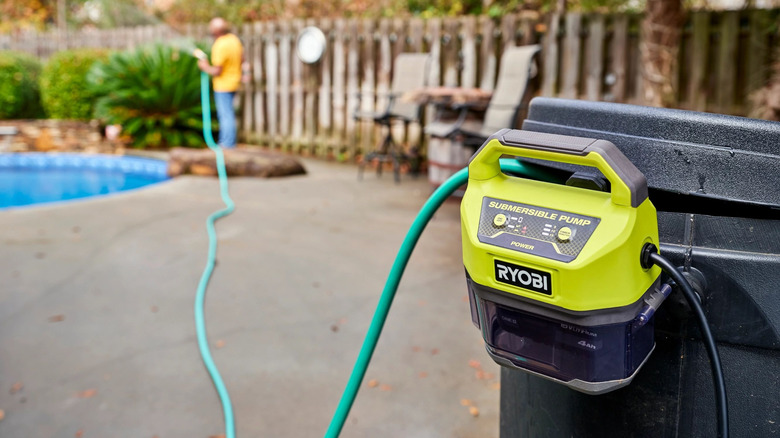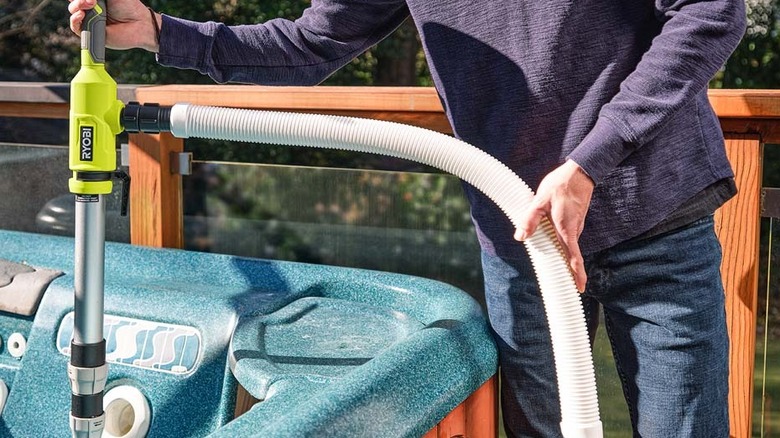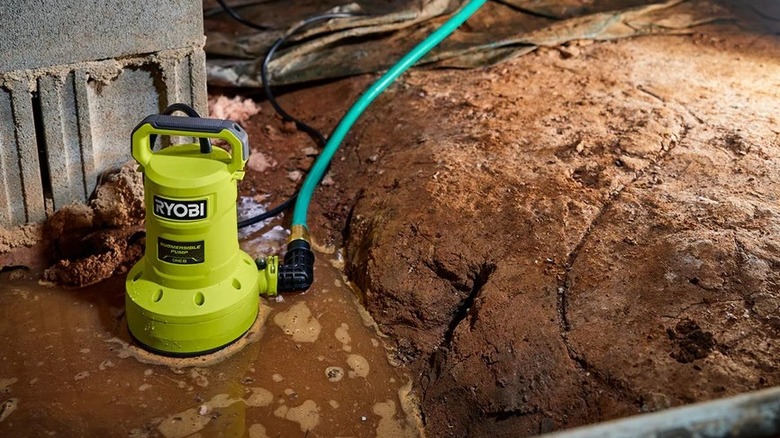Ryobi Pole Pump Vs. Submersible Pump: How Do These Two Water Transfer Tools Differ?
Ryobi's tool lineup spans a wide range of segments, from home landscaping essentials to automotive tools. With such a broad array of tools on offer, it's inevitable that a few of them might seem to overlap on first impressions. Take, for example, the brand's 18V One+ Telescoping Pole Pump, which retails, in tool-only form, for $159. It's designed to pump water from a variety of sources, and runs using the brand's well-known 18V One+ interchangeable battery packs. It seems pretty similar to the 18V One+ Submersible Water Transfer Pump, at least at a glance. The latter tool is also very similarly priced, retailing for $165.17 as a standalone tool.
Although they both ostensibly do the same job — transfer water from one place to another — there are a few key differences between them. Working out which one is best for you will mean taking a closer look at the similarities and differences between each. First, let's break down the similarities: Both use 18V One+ battery packs, and both can be bought either as standalone tools or in kit form with a battery and charger.
Buying the kit is a good way to dip a toe into the Ryobi cordless tools ecosystem if you're new to the brand, but if you already have a Ryobi 18V One+ or 18V One+ HP battery in your arsenal, the standalone tool might be better value for money. Both tools also feature a motor with a 1/6 horsepower output, although that results in different pumping capacities.
What is the difference between the two Ryobi pumps?
They might be similar in some aspects, but there are plenty of differences between the tools. For starters, Ryobi's telescoping pole pump can transfer up to 15 gallons of water per minute, while its submersible pump can transfer up to 20 gallons per minute. However, the submersible pump has a slightly lower head height, pumping water up to 23 feet above the source level compared to the pole pump's 24 foot head height. The submersible pump can be used in both hot water and chlorinated water, while the pole pump is best suited to pumping cold water.
Both pumps have sealed battery enclosures to prevent water ingress, but only the submersible pump can be left to run independently. Thanks to its upright design, users will have to stay holding the pole pump while it's in operation. With a 2Ah battery, Ryobi claims the pole pump can run for up to 26 minutes. The brand does not give a runtime estimate for the submersible pump. Another difference involves the discharge method between the two pumps: The pole pump comes with a three-foot discharge hose, whereas the submersible pump will need to be connected to a garden hose in order to discharge water.
Different pumps for different uses
There is a considerable overlap in uses between the two pumps, particularly if you're only ever planning on using them at home. Both are suitable for clearing flooded basements, transferring water from rain barrels, or clearing pooled water around the yard. However, the additional portability of the pole pump, alongside its integrated discharge pump, makes it a better option if you need to take it with you on the go, or pump multiple smaller pools of water across your yard.
The submersible pump is the better choice for emptying larger bodies of water, particularly pools or hot tubs, since it can deal with hot, cold, and chlorinated water, and it has a faster peak discharge rate. It's also a better option if you're looking to leave the pump running unattended, rather than holding the pump over the water source like you'd have to with the pole pump. Either pump will be a useful addition to a tool collection for the right buyer, particularly if you live somewhere that frequently has to deal with flooding. If that's the case, then it's also worth checking out Ryobi's other tools that may come in handy for clearing flooded rooms in your home.


